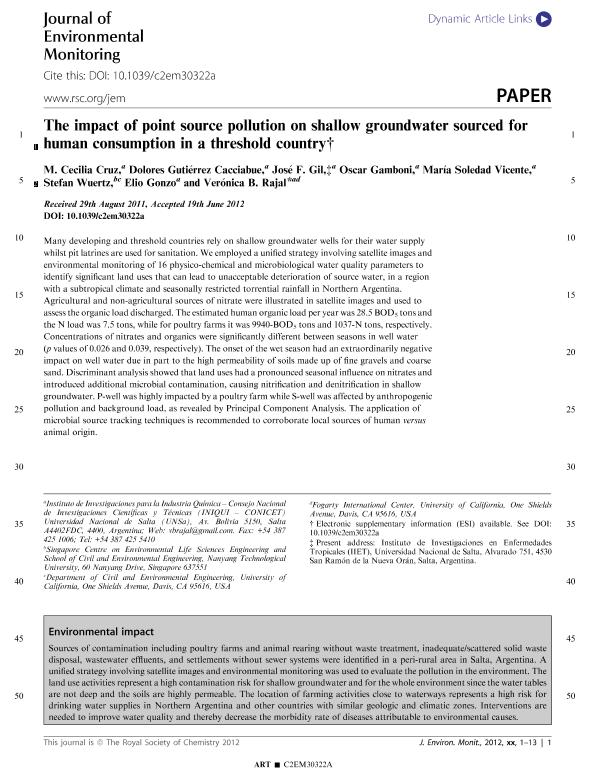Mostrar el registro sencillo del ítem
dc.contributor.author
Cruz, Mercedes Cecilia

dc.contributor.author
Gutiérrez Cacciabue, Dolores

dc.contributor.author
Gil, José Fernando

dc.contributor.author
Gamboni, Oscar Roberto

dc.contributor.author
Vicente, María Soledad

dc.contributor.author
Wuertz, Stefan

dc.contributor.author
Gonzo, Elio Emilio

dc.contributor.author
Rajal, Verónica Beatriz

dc.date.available
2022-06-08T17:46:45Z
dc.date.issued
2012-06
dc.identifier.citation
Cruz, Mercedes Cecilia; Gutiérrez Cacciabue, Dolores; Gil, José Fernando; Gamboni, Oscar Roberto; Vicente, María Soledad; et al.; The impact of point source pollution on shallow groundwater used for human consumption in a threshold country; Royal Society of Chemistry; Journal Of Environmental Monitoring; 9; 6-2012; 2338-2349
dc.identifier.issn
1464-0325
dc.identifier.uri
http://hdl.handle.net/11336/159266
dc.description.abstract
Many developing and threshold countries rely on shallow groundwater wells for their water supply whilst pit latrines are used for sanitation. We employed a unified strategy involving satellite images and environmental monitoring of 16 physico-chemical and microbiological water quality parameters to identify significant land uses that can lead to unacceptable deterioration of source water, in a region with a subtropical climate and seasonally restricted torrential rainfall in Northern Argentina. Agricultural and non-agricultural sources of nitrate were illustrated in satellite images and used to assess the organic load discharged. The estimated human organic load per year was 28.5 BOD5 tons and the N load was 7.5 tons, while for poultry farms it was 9940-BOD5 tons and 1037-N tons, respectively. Concentrations of nitrates and organics were significantly different between seasons in well water (p values of 0.026 and 0.039, respectively). The onset of the wet season had an extraordinarily negative impact on well water due in part to the high permeability of soils made up of fine gravels and coarse sand. Discriminant analysis showed that land uses had a pronounced seasonal influence on nitrates and introduced additional microbial contamination, causing nitrification and denitrification in shallow groundwater. P-well was highly impacted by a poultry farm while S-well was affected by anthropogenic pollution and background load, as revealed by Principal Component Analysis. The application of microbial source tracking techniques is recommended to corroborate local sources of human versus animal origin.
dc.format
application/pdf
dc.language.iso
eng
dc.publisher
Royal Society of Chemistry

dc.rights
info:eu-repo/semantics/openAccess
dc.rights.uri
https://creativecommons.org/licenses/by-nc-sa/2.5/ar/
dc.subject
Environmental
dc.subject
Contamination
dc.subject.classification
Ciencias Medioambientales

dc.subject.classification
Ciencias de la Tierra y relacionadas con el Medio Ambiente

dc.subject.classification
CIENCIAS NATURALES Y EXACTAS

dc.title
The impact of point source pollution on shallow groundwater used for human consumption in a threshold country
dc.type
info:eu-repo/semantics/article
dc.type
info:ar-repo/semantics/artículo
dc.type
info:eu-repo/semantics/publishedVersion
dc.date.updated
2022-06-06T15:51:00Z
dc.journal.number
9
dc.journal.pagination
2338-2349
dc.journal.pais
Reino Unido

dc.journal.ciudad
Cambridge
dc.description.fil
Fil: Cruz, Mercedes Cecilia. Consejo Nacional de Investigaciones Científicas y Técnicas. Centro Científico Tecnológico Conicet - Salta. Instituto de Investigaciones para la Industria Química. Universidad Nacional de Salta. Facultad de Ingeniería. Instituto de Investigaciones para la Industria Química; Argentina
dc.description.fil
Fil: Gutiérrez Cacciabue, Dolores. Consejo Nacional de Investigaciones Científicas y Técnicas. Centro Científico Tecnológico Conicet - Salta. Instituto de Investigaciones para la Industria Química. Universidad Nacional de Salta. Facultad de Ingeniería. Instituto de Investigaciones para la Industria Química; Argentina
dc.description.fil
Fil: Gil, José Fernando. Consejo Nacional de Investigaciones Científicas y Técnicas. Centro Científico Tecnológico Conicet - Salta. Instituto de Investigaciones para la Industria Química. Universidad Nacional de Salta. Facultad de Ingeniería. Instituto de Investigaciones para la Industria Química; Argentina. Universidad Nacional de Salta. Sede Regional Orán. Instituto de Investigación de Enfermedades Tropicales; Argentina
dc.description.fil
Fil: Gamboni, Oscar Roberto. Consejo Nacional de Investigaciones Científicas y Técnicas. Centro Científico Tecnológico Conicet - Salta. Instituto de Investigaciones para la Industria Química. Universidad Nacional de Salta. Facultad de Ingeniería. Instituto de Investigaciones para la Industria Química; Argentina
dc.description.fil
Fil: Vicente, María Soledad. Consejo Nacional de Investigaciones Científicas y Técnicas. Centro Científico Tecnológico Conicet - Salta. Instituto de Investigaciones para la Industria Química. Universidad Nacional de Salta. Facultad de Ingeniería. Instituto de Investigaciones para la Industria Química; Argentina
dc.description.fil
Fil: Wuertz, Stefan. Nanyang Technological University. Singapore Centre for Environmental Life Sciences Engineering; Singapur. University of California; Estados Unidos
dc.description.fil
Fil: Gonzo, Elio Emilio. Consejo Nacional de Investigaciones Científicas y Técnicas. Centro Científico Tecnológico Conicet - Salta. Instituto de Investigaciones para la Industria Química. Universidad Nacional de Salta. Facultad de Ingeniería. Instituto de Investigaciones para la Industria Química; Argentina
dc.description.fil
Fil: Rajal, Verónica Beatriz. Consejo Nacional de Investigaciones Científicas y Técnicas. Centro Científico Tecnológico Conicet - Salta. Instituto de Investigaciones para la Industria Química. Universidad Nacional de Salta. Facultad de Ingeniería. Instituto de Investigaciones para la Industria Química; Argentina. University of California; Estados Unidos
dc.journal.title
Journal Of Environmental Monitoring

dc.relation.alternativeid
info:eu-repo/semantics/altIdentifier/url/https://pubs.rsc.org/en/content/articlelanding/2012/EM/c2em30322a
dc.relation.alternativeid
info:eu-repo/semantics/altIdentifier/doi/http://dx.doi.org/10.1039/c2em30322a
Archivos asociados
